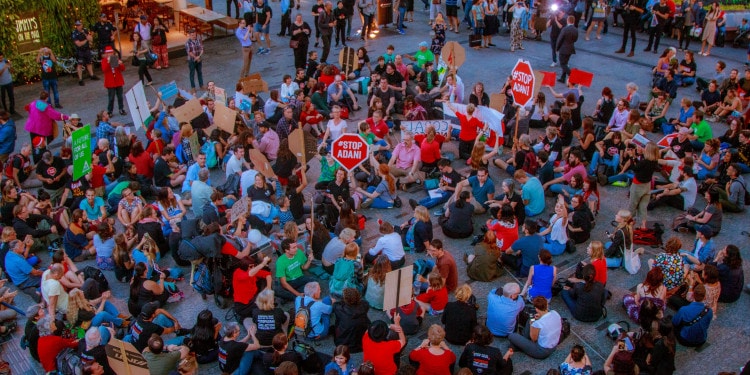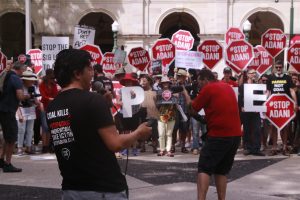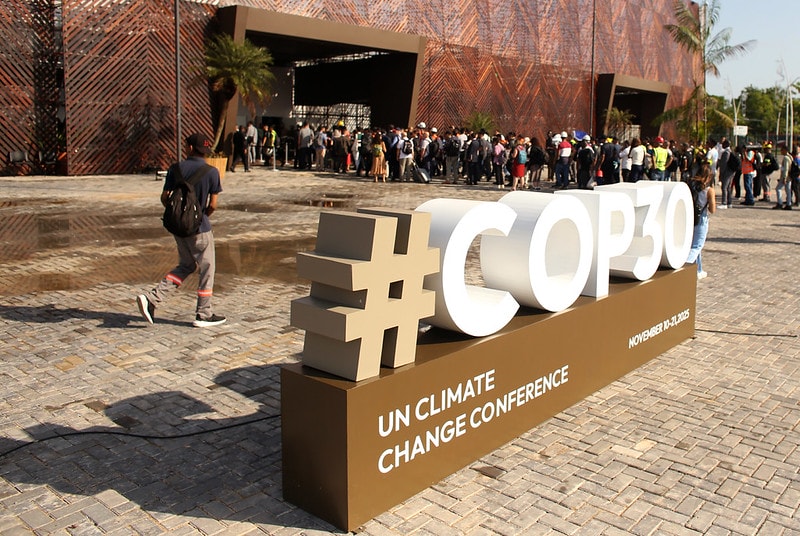The Stop Adani movement has one goal, as per its simple and snappy name: to stop the Adani Group, an Indian energy mogul, from building Australia’s biggest coal mine.
The Carmichael project in Central Queensland, which would be one of the world’s biggest coal mines, was proposed by the Adani Group in 2010. As the Queensland Government considered it an economic asset, the project was granted initial approval in 2014, followed by official approval in 2016. Despite mainstream political support, the growing number of controversies linked to the project has resulted in emerging opposition. Simultaneously, a community grassroots movement formed, soon becoming one of the largest environmental movements in Australia’s history.
THE BACKGROUND
To understand the dispute between the Adani Group and the Australian public, it is worth delving into the Australian energy landscape.
Over 80 percent of Australia’s electricity is sourced from fossil fuels, making the sparsely-populated country one of the world’s biggest carbon emitters per capita. Australia is also the world’s biggest coal exporter, with Asia and its rapidly rising energy consumption the country’s primary customer. Profits from coal exports contribute to Australia’s economy, helping it become the second richest country in the world in terms of distributed wealth per adult. However, the economic significance of coal is often overestimated, especially by Australians in the state of Queensland where the history of mining traces back over two hundred years.
The proposed Carmichael coal mine would stretch for over 30 kilometres and include the development of a 189-kilometre railway connecting the mine to the existing Hay Point and Abbot Point coal terminals, which would both be expanded. The project would also involve the construction of a private Adani airstrip in Townsville. The Adani Group intends to keep the mine open for 60 years and produce 60 million tonnes of coal annually, most of which would be exported to India. The project is marketed as a significant employment provider for Queensland, estimating it would create 10,000 jobs over its lifetime.
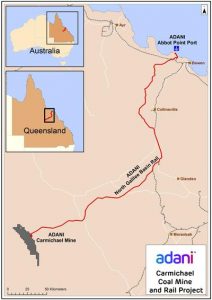
IN THE PHOTO: Map of the proposed Carmichael coal mine. CREDIT: Galilee Blockade
Adani’s proposition and approval should not come as a surprise, as Australia’s federal government has a strong tendency to support fossil fuels. There are links between the Australian federal political sphere and the coal lobby as manifested by Scott Morrison, the Treasurer of Australia, who brought a lump of coal into parliament in early 2017 to demonstrate its friendly and desirable nature as an energy source while decrying Australia’s supposed ‘pathological fear’ of coal.
VIDEO: Scott Morrison brings a lump of coal into the Australian Parliament. SOURCE: Australian Parliament House via Storyful News
Despite federal support for fossil fuels, renewable energy is surprisingly popular among Australians. Not only is 81 percent of the public supportive of renewables becoming the country’s main energy source, but Australians are personally taking advantage of their country’s renewable potential. In 2016, Australia became the top country in the world for residential solar installations, with up to 30 percent of households purchasing their own solar panels in states such as Queensland.
Despite the Adani Group’s financially questionable ventures into renewable energy production in Australia, it seems they may have underestimated public disapproval towards investing in fossil fuels and opening new coal mines. They may have been encouraged by the common belief among the Queensland public that the coal industry contributes a lot more to the state’s economy than it actually does. Both the Adani Group and the state government may have been misled, believing that the project would be readily accepted by the Australian public despite its environmental impact.
This oversight is now turning the tide against the proposed Carmichael mine.
Numerous issues linked to the project, from environmental concerns to corruption, have been raised by the Australian public. One of the biggest concerns held by people opposed to the Carmichael mine was its size, as the coal it would produce would release up to 120 millions of tonnes of CO2 annually when burned, which is more than emissions of individual countries such as Austria and Chile. This would significantly contribute to climate change and increasingly frequent extreme weather events across the globe.
Moreover, the project would not only involve building a new mine but also dredging the coastline in the UNESCO-listed Great Barrier Reef area in northern Queensland. This would be potentially deadly to big parts of the Reef and the marine life systems it supports, as well as many of the 60,000 tourism jobs in Queensland. This issue is also connected to the dispute over Adani’s employment creation promise, as during one of the numerous court cases against the Adani Group, a lawyer hired by the energy mogul admitted that the mine would only create 1,464 full-time jobs, not the previously stated 10,000.
The list of problems does not end there. The project has been accused of ignoring the indigenous rights of the Traditional Owners of the land where the mine was proposed to be built – the Wangan and Jagalingou people. The mine also potentially threatens thousands of farmers, as it has been granted unlimited access to groundwater from the Great Artesian Basin, which lies underneath 22 percent of the Australian continent. Building the Carmichael mine would also involve clearing over 20,000 ha of land, an area of size equivalent to 28,000 football pitches, threatening endangered animal and plant species such as koalas and some migratory birds.
The wide-ranging issues attached to the Carmichael mine project are where the Stop Adani movement has found its strength. Highlighting controversies that would potentially affect a multitude of communities across Australia has allowed the movement to bring people from all walks of life together to fight for a greater goal – stopping the Carmichael mine from being built, and taking major steps toward securing a sustainable future for Australia.

IN THE PHOTO: AYCC members during a Stop Adani street action in one of the areas targeted during the election campaign. CREDIT: Tahlia Clarke/AYCC. Source: AYCC
STOP ADANI – THE LINK BETWEEN SDGS AND COMMUNITY ACTION
Incidentally, addressing issues attached to the proposed Carmichael mine corresponds with achieving many of the United Nations (UN) Sustainable Development Goals (SDGs), including:
- SDG 13 Climate Action – preventing additional potential carbon emissions from the Carmichael mine, further contributing to rising temperatures and climate change,
- SDG 15 Life On Land – protecting land and endangered species while preventing land clearing,
- SDG 14 Life Below Water – preventing dredging and protecting the Great Barrier Reef, already strained from increasingly common bleaching events,
- SDG 6 Clean Water and Sanitation – protecting the Great Artesian Basin and the access to safe and clean groundwater it provides across 22 percent of Australian land,
- SDG 16 Peace, Justice and Strong Institutions and SDG 10 Reduced Inequalities – protecting indigenous rights of the Australian Traditional Owners to manage their land,
- SDG 7 Affordable and Clean Energy – moving away from fossil fuels and increasing opportunities for growth in renewable energy sector instead,
- SDG 3 Good Health and Well-being – preventing negative health impacts from coal mining, such as respiratory problems and heart disease caused by inhaled coal dust.
Australia is among the 193 countries who adopted the 2030 Agenda for Sustainable Development in late 2015. The Agenda’s aim is achieving seventeen global goals, the SDGs, which the UN considers a responsibility of adoptee’s national governments. The UN website says that the SDGs “implementation and success will rely on countries’ own sustainable development policies, plans and programmes, and will be led by countries.”
The UN also encourages collaboration and stresses the need for partnerships between different stakeholders within countries in order to achieve SDGs, stating:
“All stakeholders: governments, civil society, the private sector, and others, are expected to contribute to the realisation of the new agenda. (…) Multi-stakeholder partnerships have been recognised as an important component of strategies that seek to mobilize all stakeholders around the new agenda.”
Stop Adani is a great example of how grassroots community movements can lead the way to achieving SDGs in countries where governments are reluctant or sluggish to act. Over the past few years, the movement evolved from a localised Queensland issue into a campaign supported by over 100 Stop Adani groups across Australia. Community leadership has been at the core of Stop Adani from its beginning and has been a crucial factor in securing nationwide support. The movement is on its way to influencing national policies on sustainability-related issues such as fossil fuel reliance and renewable energy growth thanks to its focus on political campaigning.
Though the assumption that governments are essential to achieving SDGs might be wrong, it is true that there is a need for partnerships and mutual effort across stakeholder groups in order to accelerate the move towards a sustainable future. This was also true for Stop Adani, as to become an effective movement, it needed help in merging numerous local volunteer efforts into a national body with a centralised strategy.
This became possible with the creation of the Stop Adani Alliance in early 2017. The group connects third sector organisations campaigning against the proposed Carmichael mine and amplifies the many Adani-opposed voices. Subsequently, the Alliance became the driving force behind establishing the Carmichael mine project as the top issue during Queensland’s snap state election in November 2017, which was a pivotal moment for the movement.
Establishing an issue which would impede achieving numerous SDGs as a top public concern during political elections is a significant step towards accomplishing the UN’s 2030 Sustainable Agenda in Australia. The effort could potentially be replicated by stakeholders in other countries where national governments are not fully committed to achieving the SDGs. Therefore, it is worth analysing Stop Adani’s strategy during the 2017 Queensland elections and identifying the tactics effective in building national support for achieving SDGs in Australia through political action.

IN THE PHOTO: Shannon Hurley, left, with AMCS volunteers calling on Queensland Premier to reject the Adani Group’s proposal. CREDIT: Zachary Staines/AMCS. Source: AMCS
GRASSROOTS MOVEMENT INFLUENCING AUSTRALIAN POLITICS
On the 29th of October, the Queensland Premier and leader of the Australian Labour Party, Annastacia Palaszczuk, called for snap Queensland elections to be held a month later, on the 25th November. The move came as a bid to strengthen her party’s rule and secure a majority of seats in the Queensland parliament.
In the run-up to the elections, Queensland Labour and Palaszczuk were vocal supporters of the proposed Carmichael mine, signing agreements with the Adani Group and facilitating state approvals, while ignoring public opposition to the project and citing its economic benefits.
The growing opposition to the proposed Carmichael mine was fuelled when, despite assuring the public that the project will finance itself, the Adani Group applied for a public loan provided by the federal government via the Northern Australia Infrastructure Facility (NAIF). The NAIF fund was created in 2016 to support major projects in northern Australia, and has been criticised since for its lack of transparency as decisions made by its board are largely secretive, potentially encouraging corruption.
If approved, Adani would have received a $900 million federal loan with low-interest rates, which was a significant portion of the $16.5 billion investment it needed to go ahead. This essentially meant the Carmichael mine would be in part financed by the public, undermining its status as a significant asset for the Australian economy.
The controversial use of public money towards a project run by a foreign company became the focus of the Stop Adani campaign during the elections, as polls suggested that nearly 70 percent of the public didn’t want taxpayer money supporting the project. Moreover, as it was revealed that the Queensland Premier had the power to veto the NAIF loan, members of the Stop Adani Alliance focused on ensuring that stopping the funds became the top election issue.
During the first week of the election campaign, after mounting pressure from numerous organisations and volunteers from the Stop Adani Alliance, Premier Palaszczuk announced that she would veto the federal NAIF loan to Adani if elected, which was hailed as one of the greatest successes of the Stop Adani campaign. I spoke to some Brisbane based community organisers from the Australian Marine Conservation Society (AMCS), Australian Youth Climate Coalition (AYCC) and GetUp, which were among the Stop Adani Alliance member groups involved in the Queensland election campaign, in order to learn more about how they successfully established the Carmichael mine as a top political issue.
One of the people I spoke to was Shannon Hurley, a Reef Campaigner with the Australian Marine Conservation Society, an environmental NGO working to protect Australian marine life. She told me how her organisation utilised their ongoing campaign to protect the Great Barrier Reef to mobilise supporters during the election period and put pressure on the Queensland Premier.
Hurley said, “AMCS’s main role in the election campaign was to mobilise people to really step up and take action and make their voices heard, whether that was attending a rally or contacting a local politician and letting them know how they felt about the Stop Adani campaign and the Great Barrier Reef. It was about putting pressure on our elected representatives to do better to protect the Reef, and not allow $1 billion of taxpayers’ money to go to Adani because we knew that if the project would go ahead, it was really going to have disastrous impact on our Reef.”
Apart from community mobilisation and the ensuing political pressure, Hurley also highlighted the importance of the Stop Adani Alliance movement’s ability to create media buzz from the start of the election campaign.
“I think what we were able to do well was having a constant media presence and that helped us set the tone for the election. I think that’s what helped to lead to the Premier vetoing the loan. Our focus was about creating lots of colour and movement – we would go out to do rallies and hold signs and banners at popular street corners, making sure that all major parties that were a contestant in the election get the message and commit to better policies for our Reef.”
The importance of constant media presence was also highlighted by other organisational members of the Alliance. Nick Carter works as a Community Organiser with the Australian Youth Climate Coalition, an organisation comprised of young Australians working towards tackling climate change. He explained the reasons behind the Stop Adani movement’s focus on the newsworthy direct action during the election campaign, which was one of AYCC’s main tactics.
IN THE PHOTO: Nick Carter and Stop Adani protesters attracting media attention during one of their rallies in Brisbane. CREDIT: Alexander Watson/AYCC. Source: AYCC
“The overall goal was to get a policy commitment from political parties to stop taxpayer money going to Adani. Our strategy as a movement was to highlight how much community opposition there was to tax money going to Adani and how people would rather see their money going anywhere else and to make our campaign the centre of attention for the election period,” Carter said.
“We really wanted to do actions that were flashy and showy and public so that every time [people] would hear the word ‘Adani’ they would associate it with the word ‘Stop’. We had success with some traffic actions in one of our target electorates where we would stand with Stop Adani signs on the sidewalk and have thousands of motorists driving by who would see people out there on the streets. And unlike a lot of other political campaigns, we were simply saying that we need to stop this mine.”
After Premier Palaszczuk promised to veto the NAIF loan if elected, the Stop Adani Alliance shifted its focus to swaying votes in marginal seats in favour of political parties opposing the loan. The tactics transitioned from targeting politicians to engaging communities in key political areas.
Ray Yoshida is a member of the Stop Adani Brisbane group and a Community Organiser with GetUp, an NGO focusing on working towards a better informed and progressive democracy in Australia. He told me about GetUp’s tactics as a Stop Adani Alliance member during the second half of the election campaign, which mainly included mobilising volunteers and engaging with communities in key political areas.
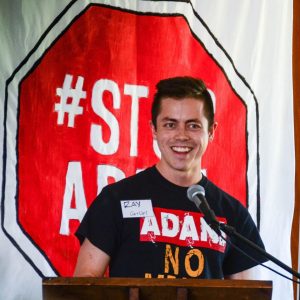
IN THE PHOTO: Ray Yoshida during a Brisbane Stop Adani summit in September 2017. Picture: Stop Adani Brisbane.CREDIT: Ray Yoshida, via Facebook
GetUp got involved in the election in earnest after the Premier announced at the end of the first week that her government if elected, will veto the NAIF loan. From then on, we had a mix of field and digital tactics aiming to inform voters on where the major parties stand on Adani loan. One of them was phone calls. GetUp members and Stop Adani volunteers all across the country made 130,000 calls to key marginal electorates to have conversations with the voters on the $1 billion loan. We saw a swing in the electorates we were calling so we definitely made an impact, with a few of those seats switching,” Yoshida said.
The Stop Adani movement, comprised of mobilised volunteers taking diverse political action throughout the election campaign, helped establish the Carmichael mine as a top political issue and elect a Labour government which promised to act, even if only by vetoing the public funding for the project. This is a step on the path toward achieving a sustainable future for Australia but plenty remains to be done, even if the Carmichael mine does not go ahead.
Talking about what will happen to the Stop Adani movement if Adani is stopped, my interviewees were positive that the movement will only continue to grow. Yoshida told me that next year the Stop Adani Alliance will be working to shift the movement from focusing on one coal project to coal mining in general, which is crucial in tackling climate change and ensuring a sustainable future.
“Across next year we’ll be shifting into talking more about no new coal and how there needs to be a moratorium on either coal mining and new coal-fired power stations in Australia. Stop Adani is a huge network of groups and individuals across the country taking action, who not only want to stop this mine but also value a climate safe future and they understand that we need no new coal mines to have that future. I think people in this network will really enthusiastically jump on the no new coal campaign,” Yoshida said.
CONCLUSION
Achieving all seventeen SDGs and securing a sustainable and safe future for everyone is a big challenge as it entails extensive social, political and economic changes across the globe. When considering goals such as SDG 13 Climate Action, achieving the 2030 Sustainable Agenda means transformations will need to take place not only in rapidly developing countries, such as China and India but also in developed countries heavily relying on coal for energy production, such as Australia. Transitioning to sustainable energy sources might prove even more difficult in the latter case, as governments in coal-dependent developed countries often hold close ties with the fossil fuel industry, which can impede their climate action.
As shown by the case of the Adani Carmichael mine, other stakeholders, such as the civil society and third sector, can take the lead and start making steps toward achieving SDGs in their countries. To be effective, however, these stakeholders need to act together. Establishing collaborations and partnerships between the civil society and third sector is crucial in achieving the 2030 Sustainable Agenda. The grassroots movement behind the Stop Adani campaign might not have been as successful in influencing the Australian political landscape were it not supported by the numerous NGOs who joined the Stop Adani Alliance. And vice versa: the Stop Adani Alliance might not have been as successful in mobilising major public support were it not backed by the numerous local Stop Adani volunteer groups.
Though the path to a sustainable future in Australia does not end at stopping one new coal mine, the Stop Adani movement is a step toward publicising the need for action and merging multiple efforts to secure action on the issues encapsulated by the SDGs, including land clearing, public health, marine life and indigenous rights. By utilising tactics such as strategic collaboration, community engagement and media pressure, Stop Adani has been able to influence Australian state elections and help establish achieving a sustainable future as a major political issue. This is a significant achievement and should be replicated by stakeholders in other countries looking for ways to encourage their governments to work toward achieving the 2030 Sustainable Agenda.
There are many ways in which these kinds of partnerships can be established. Local communities and grassroots movements can seek support from the third sector in amplifying their voices. The third sector can actively seek opportunities to engage with communities in local areas on issues they both care about. Different NGOs with shared interests can seek new ways to work with each other in order to increase their social and political weight. The ensuing collaborations will strengthen the voices behind the issues raised, and with the right tactics, give them the power to engage with their national governments and work toward achieving SDGs in their countries.
FEATURED PHOTO: Stop Adani supporters during one of the protests organised in Brisbane. CREDIT: Alexander Watson/AYCC
Editors note: The opinions expressed here by Impakter.com columnists are their own, not those of Impakter.com


